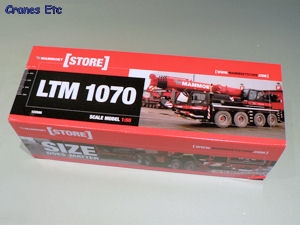 | | The box sleeve is in the Mammoet house style. |  | 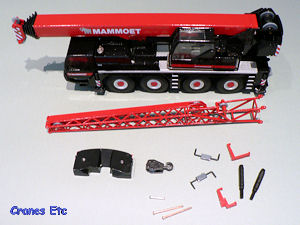 | | Various pieces from the box. | 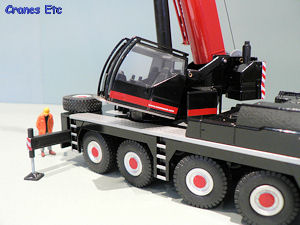 | | Plastic outrigger beams and tilting cab. | 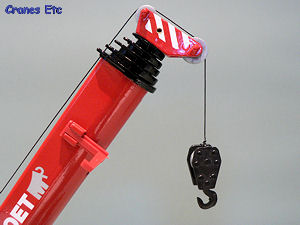 | | Boom head detail. Support for the fly jib is shown. | 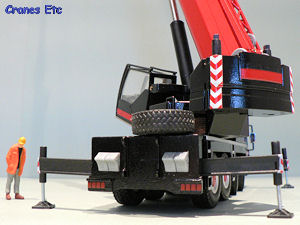 | | Outrigger beams can hold the weight but they flex a little. | 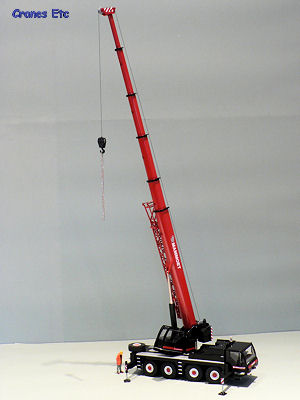 | | Six section telescope allows plenty of reach. | 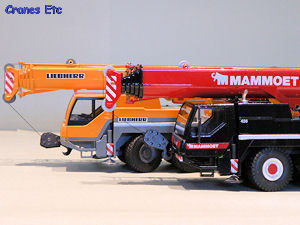 | | 1060 v 1070. Boom has an extra telescope section on the 1070, and the block has a single hook rather than the double on the 1060. |
| The Liebherr LTM1070 Mobile Crane is an updated version of the previous model, the LTM1060. Features of the newer crane are an increase in the rating from 60 to 70 tonnes and a longer telescopic boom. Conrad are the maker of both versions of the model, with the earlier one being numbered 2094 and it was reviewed here. Liebherr refer to the crane by its full name as the LTM 1070-4.1.
The review model is in the livery of Mammoet, a popular choice with collectors.
Packaging
The box was in a typical Mammoet style box with a photo of the real machine in Mammoet colours. Inside, the box is the same as the standard Liebherr version with the model held tightly within a two piece expanded polystyrene tray. Small parts are supplied in a plastic bag tucked into the box.
As usual with a model of this type there are no instructions provided although it is obvious where the parts go and only a novice would take a little time to figure it out.
The review model was undamaged when unpacked.
Detail
Looking at the carrier first, underneath there is really no chassis detailing at all and the model is purely functional. The tyres and wheel hubs are the standard Conrad variety and are perfectly good although on the real machine axle 2 is not driven so has a different hub to the other axles.
The driving cab has some detailed headlights, a loop for attaching the hook during transport and also wing mirrors. It is a little surprising that there are no orange beacon lights. Inside, the cab has the major features represented.
The carrier deck has a good mixture of cast in details including textured walkway surfaces, and steps to enable access on to the deck. There is also a detailed exhaust and fuel tank, and a spare wheel is attached at the rear. At the back, wheel chocks are provided and there are painted lighting clusters. Outrigger beams are plastic as are the outrigger pads.
The operator's cab is simply detailed with no mirrors or wipers although the metal grab rails are very good. Inside the seat and controls are well represented. The rest of the crane body is uncluttered and looks sharp. At the rear the counterweight ballast is in two. One piece is fitted as part of the superstructure and has the Liebherr name raised as part of the casting and this is a quality touch. The second piece is a detachable block which although solid is cast to represent two separate plates. It is held in place by two plastic lift cylinders with screwed ends. Unfortunately these are straight from the previous version of the model and are not present on the real crane. As a minimum they should have been halved in length to make them less visible.
The boom is also simply detailed with the mid boom cable drum not modelled and the boom cross section is not quite faithful to the original 'oviform' design on the upper sides. It is a six section telescope. At the boom head the pulleys are plastic but disappointingly not separate as they are in moulded pairs which restricts their ability to run freely with a multi line hook.
The fly jib lattice section is a very good casting. It connects to the boom head via the usual pin system and attaches to the boom side with removable plastic brackets for transport. The swing away jib section appears to be plastic but looks good nonetheless.
To complete the model a metal hook block is provided which has a single plastic set of three pulleys so again free running of the hoist rope cannot occur.
Features
Steering of the axles is very good. They operate in linked pairs so all the modes of the original machine can be replicated and an excellent hard lock can be obtained.
All the usual crane functions can be carried out and this makes the model great for displaying in different ways. The winch can be operated by turning the serrated edge of the drum with a finger which works fine although it is not comfortable on the finger for long.
The crane cab can be tilted and the counterweight can also be removed by unscrewing the dummy lifting cylinders. It stows very well on the carrier deck and looks realistic in transport mode.
The fly jib can be fixed and operated in folded and unfolded modes although it cannot be offset at an angle as can the original.
Quality
Conrad have a produced another model which is typical of their high standards. It is well engineered, with a high standard of casting and the paintwork and lettering on the Mammoet version of the model is very good.
It is a heavy model for its size, with limited use of plastic.
Price
The model is good value for the quality offered.
Overall
Collectors will be pleased to have this model in their collection as it is a quality Conrad product. It is an updating of the previous model, the LTM1060, and reflects the key changes that were made to the full size machine. However in a sense perhaps the updating of the model did not go far enough and an opportunity has been missed to add more detail generally, and perhaps functionality also in terms of the fly jib having an offset mechanism and amending the ballast connection to reflect the original. Despite the minor reservations, the model is recommended.
If you already have the previous LTM 1060 model, should you buy this one? They are very similar and the decision really boils down to whether you want to collect every version or are happy with just one 4-axle model.
Footnotes
The model first appeared at the Nuremberg Toy Fair in February 2006 and was the successor to the Liebherr 1060/2 (Conrad 2094). It appeared at retailers in August 2006. A version in Mammoet colours appeared in 2006. In December 2007 minor amendments were made to the model. The crane cab was replaced with a later version from the LTM1200, a Liebherr flag was added and the hook block has twin hooks. A version in Ainscough colours appeared in 2008.
|
| |
| 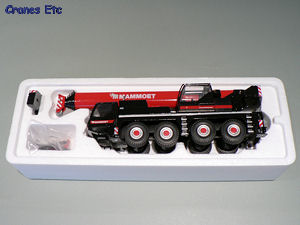 | | The model is securely packed. | 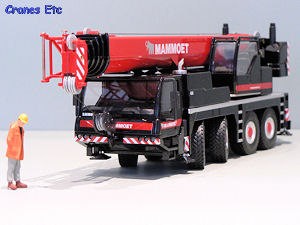 | | Loop at the front allows the hook to be attached when the crane is moving. | 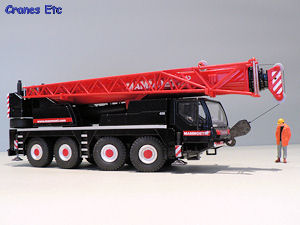 | | Fly jib stows well. | 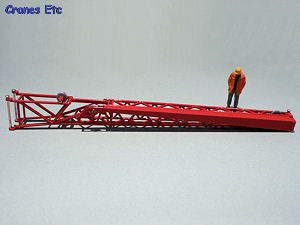 | | The fly jib has a folding section but is not adjustable for angle like the real thing. | 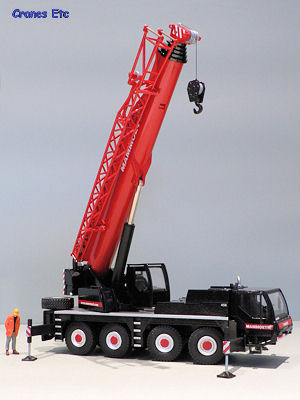 | | Ready for work. | 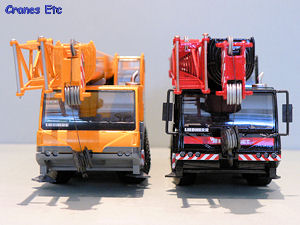 | | 1060 v 1070. Updated cab details, a loop for the hook and wing mirrors on the 1070. | 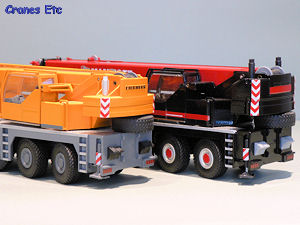 | | 1060 v 1070. Counterweight block is larger on the 1070 and the dummy ballast lifting rams sit higher. |
|

